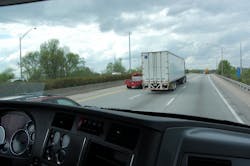Insurance is one of those “must haves” in the commercial trucking business, not in the least due to all the potential risks truckers face day in and day out – even going so far as to include cyber-attacks in the mix.
And let there be no doubt: crashes and the resulting insurance claims can pack quite a punch on the bottom line of any motor carrier.Take Cudahy, WI-based Roadrunner Transportation Systems for example: Mark DiBlasi, the carrier’s president and CEO, noted in the company’s year-end earnings report that “unfavorable claims developments” during the fourth quarter of 2013 – primarily related to increased accidents involving claims, accelerating costs on settled claims and, correspondingly, increased reserves on new claims – totaled some $3.8 million more compared to the fourth quarter of 2012, causing a six-cent impact on diluted income per share in the fourth quarter of 2013, he said.
That’s not chump change by any means.
Yet there are still plenty of opportunities for trucking firms large and small to minimize their insurance expenses – a bottom-line cost that global consulting firm Frost & Sullivan, for one, believes makes up 4% of a fleet’s total cost of operation or TCO calculation.
To that end, Bill Caudill, commercial auto product manager at Progressive Insurance, recently shared a few tips with me to help lower the cost of insurance for carriers maintaining good safety records.
First, look for discounts. “Check what discounts you’re eligible for, and make sure you’re taking full advantage of everything that’s available,” Caudill stressed. “There are many kinds of discounts, including having three years of business experience and paying your policy in full. Ask your insurer or independent agent plenty of questions to ensure you’re getting the most for your money, especially if you have an excellent driving history.”
Second, request a policy review. “If you haven’t taken a close look at your policy recently, reach out to your agent or insurer about a policy review,” he emphasized. “They can help you review your premiums and coverage to make sure that everything is up-to-date. Your truck value could come into play as well. As time goes by and you put more miles on your rig, the book value decreases and that could translate into savings.”Tip three – one that may come more into play if the driver shortage keeps worsening – is to lower coverage on trucks that are in temporary storage.
“If your truck goes into storage, consider moving it to a comprehensive-only policy,” Caudill said. “Think about it: when your truck is locked away, you don’t need collision coverage. Comprehensive coverage will protect your truck from things like theft, vandalism and fire while it’s in storage, protecting your truck from the unexpected.”
Yet this kind of switch also allows fleets to maintain continuous coverage on their equipment, which can help keep its overall insurance bill lower when its policy renewal time. “And yes, there’s often a discount for that, too,” he noted.
Fourth, look into payment plan options. “Some insurers have significant finance charges associated with their bill plans, or don’t have flexibility in payment schedules,” Caudill said. “Look for companies that offer flexible pay plans, including low initial payments and no finance charges. Rather than paying your policy premium in one annual payment or quarterly installments, you may be able to spread your premium over monthly payments, helping your insurance bill fall in line with your cash flow.”
Finally, his fifth and last tip: look for what Caudill calls “non-insurance bonuses,” such as trailer skirts.“Trailer skirts are a good way to save money on fuel costs in the long run,” he explained. “When they first started hitting the market, there was some debate about the effectiveness of trailer skirts. However, time has shown that they’re a big-time fuel saver.”
With some trailer skirts boosting fuel efficiency by up to 5%, Progressive believes they can pay dividends over time once the initial up-front cost is recouped – and such savings can be used to help cover other bottom line costs for carriers such as (you guessed it) their insurance premiums.
Technology is also getting into the insurance game, albeit obliquely, as a variety of systems are being position not just as safety enhancements for trucking firms but also as a way to gain insurance discounts as well.
Take Lytx, Inc., for example – formerly known as DriveCam, Inc. – which offers an in-cab system wired to capture both data and video of driver behavior.
While many truck drivers may object to such “Big Brother” style technology watching over them, there’s now a direct cost-saving benefit for the fleet via signed a deal Lytx recently signed with WI-based Sentry Insurance.
Under the agreement, Sentry will pay what the two firms’ term a “significant portion” of the monthly program cost associated with Lytx’s DriveCam system and further plans to make it an “integrated component” of its loss control services.
“The DriveCam program will help our customers operate safer fleets and help us protect them against fraudulent claims,” noted Dave Gibson, Sentry’s director of transportation safety services, in a statement. “We believe so strongly in the program that we’ll share a portion of our customer’s cost to implement the program.”
You can bet, too, that if a fleet’s drivers rack up good safety statistics that can be monitored via Lytx’s program, insurance discounts might be available as well – offering carriers a second potential avenue of savings.
And in this day and age when whole hosts of trucking expenses are on the rise – equipment sticker prices, driver wages and benefits, not to mention $4-plus per gallon diesel – any opportunity to save money, even on insurance premiums, is a something fleets need to take a long hard look at.



